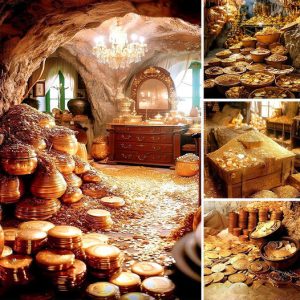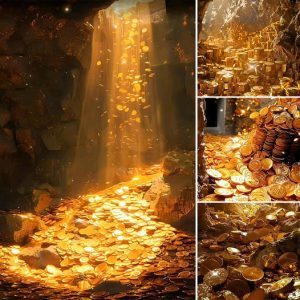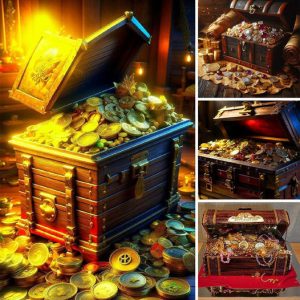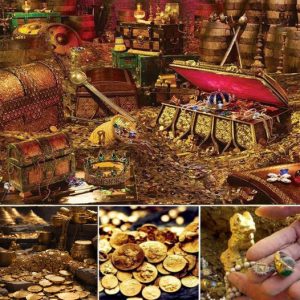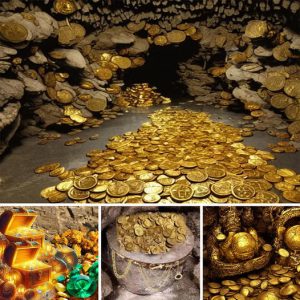
The sixth and seventh centuries are represented by the gold and silver objects from the Staffordshire Hoard, which was discovered in Staffordshire, England, in 2009. (Photo via Commons on Wikipedia; CC BY 2.0)
Every little child imagines discovering treasure that has been concealed by pirates or an old ruler. Adults may give up on these fanciful fantasies, but adventurers still have hope. Hoards, or treasure troves, are constantly being discovered all over the world. Even now, common people still find silver plates, gold bracelets, and antique monetary caches.
Finding a buried treasure trove can make someone millions, turning the life of a metal-detector hobbyist or farmer in a new direction. Each discovery also advances knowledge of local history in priceless ways. Read on to learn more about hoards, treasure, and how your childhood dream could (maybe) still happen.

A gold body chain from the Hoxne Hoard of late Roman items, discovered in 1992 in Suffolk England. (Photo: Photograph by Mike Peel via Wikimedia Commons [CC BY-SA 4.0])
What Is a Treasure Trove or Hoard?
Treasure troves, or hoards, are defined by archeologists to be a type of wealth deposit. Precious metals and stones, ceremonial artifacts, and everyday coins—hoards can comprise a variety of different metal-based objects. How these pieces come to be underground can depend on societal conditions. Political instability or war in ancient times could inspire wealthy people to hide their valuables. Typically, these people intended to return to recover their deposited wealth. Circumstances—such as war or death—could interrupt recovery, leaving the hoard to wait for chance discovery. In general, valuables found at gravesites or shipwrecks are not classified as hoards.

Treasure troves can be found across the world; however, Great Britain and Ireland can boast some of the largest and most famous discoveries. Treasure trove also has an important legal definition. Coin and bullion are defined to be treasure depending on the content of silver and gold, as well as the age of the items. In the UK, the Treasure Act 1996 governs all discoveries. In general, any finds older than 300 years and containing at least 10 percent gold or silver qualify as treasure. Pre-historic finds often qualify as well, regardless of metal content. Discoveries must be reported to the local coroner within 14 days, as found treasure has long been considered Crown property. To hide discovery can even result in prison time.

The coroner next holds an inquest—or investigation—to see if the discovered items are in fact treasure. A Treasure Valuation Committee formed of experts examines the pieces. The committee decides if the find fits the definition of treasure, and then makes a valuation. If the items are in fact within the scope of the law, the finder (and owner of the land) are required to offer the pieces for sale to a museum. These laws are in place to ensure that historic national treasures go to institutions where they will be studied, rather than merely vanishing into the hands of private collectors. In general, this scheme works well for all involved—knowledge is advanced, and the finders of the treasure make a pretty penny from their sale.

Famous Treasure Troves
The Broighter Gold

A golden boat from the Broighter Gold hoard. (Photo: Ardfern via Wikimedia Commons [CC BY-SA 3.0])
This cache of Iron Age Gold was found in Northern Ireland by farmers in 1896. Dating from the first century BCE, the gold is a fine example of intricate metal work. A torque (or torque, a twisted necklace), a bowl, and other jewelry show off the artistry of the ancient Celtic craftsmen. The most unique element of the hoard is a golden boat, complete with oars. Scholars believe the hoard was a votive deposit to a Celtic sea god.
The Preslav Treasure

Byzantine necklace from the Preslav Treasure. (Photo: Yelkrokoyade via Wikimedia Commons [CC BY-SA 3.0])
Discovered in 1978 in Castana, Bulgaria, the Preslav Treasure comprises 170 Byzantine artifacts in gold, silver, and bronze. The coins date to the 10th century CE when the items were buried during political turmoil; however, other items may date back to the 3rd century CE. The highlight of the cache is a grand golden necklace bearing a medallion of the Virgin Mary. It is possible the necklace was a wedding gift from a Bulgarian Tsar to a Byzantine princess.
The Saddle Ridge Hoard

Coins as they were found in the Saddle Ridge Hoard of the California Sierra Nevada mountains. (Photo: Kagin’s Inc. via Wikimedia Commons [CC BY-SA 3.0])
The largest buried coin hoard discovered in the United States, the Saddle Ridge Hoard of 1,427 gold coins was discovered in the Sierra Nevada mountains in 2013. Valued at 10 million dollars, the coins date from the second half of the 19th century. They were discovered in eight metal canisters, which the landowners spotted while walking their dog. The coins received conservation from numismatics experts, were valued, and were sold (for a lot!) through Amazon.
The Hoxne Hoard

Silver-gilt Roman piperatoria (pepper pots) from the Hoxne Hoard, including the famous Empress Pepper Pot (far right). (Photo: Wikimedia Commons [Public domain])
The Hoxne Hoard was discovered by a metal detector hobbyist in 1992 in Suffolk, England. One of the most important treasure troves discovered in the UK, the pieces valued millions of pounds. An oak chest contained thousands of Roman coins and pieces of jewelry which date from the fifth century—the end of the Roman occupation of Britain. Coins are useful for archeologists, as they are often easy to precisely date. Experts hypothesize that the chest was buried by a wealthy family, as it contains exquisite pieces such as gilded pepper pots, gold body jewelry, and delicately sculpted animals.
The St Ninian’s Isle Treasure Trove

A sword hilt from the St Ninian’s Isle Treasure. (Photo: Johnbod via Wikimedia Commons [CC BY-SA 3.0])
The Scottish have their share of hidden gems, too. Discovered in 1958, this hoard of early medieval silver includes delicate jewelry still seen in Scotland today. The penannular brooch—or Celtic brooch—pinned the fabric of ancient costumes, but the design is still used today for classic highland dress. Among the items found was also an intricate sword pommel with raised Celtic designs.
The Staffordshire Hoard

Anglo-saxon gold bracelet from the Staffordshire Hoard. (Photo: Hilt Fitting via Wikimedia Commons [CC BY 2.0])
The most impressive Anglo-Saxon buried treasure discovered in the UK, the Staffordshire Hoard features thousands of gold and silver items, some with garnet inlay. Discovered in a plowed field in 2009, these special artifacts were (luckily) excavated by professional archeologists at the request of the landowner. As a result, historians gained a window into 7th and 8th century Britain. The collection of martial objects is renowned for its workmanship; these objects may have been a noble votive offering upon the death of a warrior.
The Mildenhall Treasure Trove

Bacchus on the great Roman dish from the Mildenhall Treasure. (Photo: JMiall via Wikimedia Commons [CC BY-SA 3.0])
Discovered in 1942 in Suffolk, England, this is a heavy hoard. Platters, dishes, floors, and spoons from Roman Britain depict mythical scenes in raised relief. Scholars were once skeptical about the provenance (origin) of the hoard; however, later findings confirmed such luxuries existed in Roman provinces. Among the silverware is the Great Dish featuring the god of wine, Bacchus. No stranger to fine silver, the man who discovered the silver actually used the plates on special occasions before eventually turning them over to the proper authorities.
The Ziwiye Hoard

A gold rhyton (drinking horn) in the shape of a ram’s head from the Ziwiye hoard. (Photo: A. Davey via Wikimedia Commons [CC BY 2.0])
The ancient Near East has stunning treasure troves—among these is the Ziwiye Hoard. Discovered in Iran in 1947, the details of its discovery are rather murky. Many pieces have dispersed into private collections, part of the exploitive antiquities trade which accompanied Western imperialism in the Middle East. However, certain stunning items have come to define the cultural diversity of ancient Iran around the 9th century BCE. Located on the Silk Road and other trade routes, the items show Assyrian, Scythian, other regional influences. Particularly stunning is a gold rhyton in the shape of a ram’s head, a drinking cup fit for a king.
The Spillings Hoard

Viking silver from the Swedish Spillings Hoard. (Photo: W. carter via Wikimedia Commons [CC BY-SA 4.0])
Did you know the Vikings buried treasure? A Swedish cache of Viking silver discovered in 1999, the hoard included thousands of early medieval century coins. Most of the coins were of Islamic origin. This find—as well as others in Sweden—demonstrate the range of trade in the period. Viking deposits include coins from as far away as North Africa and Central Asia.
The Treasure of Villena

Gold items from the Treasury of Villena.
Hiding valuable things has apparently long been a human instinct. Around 1000 BCE, Bronze Age Spaniards buried gold bowls, bottles, and bracelets alongside iron (also considered valuable at the time). These gold items feature raised patterns, and are evidence of advanced gold-working skills in prehistoric times.
The Panagyurishte Treasure Trove

Thracian gold artifacts from the Panagyurishte Treasure. (Photo: Ann Wuyts via Wikimedia Commons [CC BY 2.0])
Discovered in Bulgaria in 1949, the Panagyurishte Treasure is Thracian gold. The Thracians were ancient Indo-Europeans who lived in the Balkans and Anatolia. The golden items were buried between 400 and 300 BCE. Mentioned in the Illiad, the Thracians are a fascinating ancient people. (You can learn more about their history on.)
The Wonoboyo Hoard

Replicas of the gold items found in the Wonoboyo Hoard, discovered in 1990 in Central Java, Indonesia. (Photo: Gunawan Kartapranata via Wikimedia Commons [CC BY-SA 3.0])
The Wonoboyo Hoard was discovered in 1990 in Central Java, Indonesia. These 9th-century golden artifacts of the Medang Kingdom—jewelry and small bowls of exceptionally fine quality—were found buried in earthen jars. Experts have suggested the items belonged to a member of the royal family. is an exquisite, ancient tradition virtually unparalleled elsewhere; to see some of the finest gold craftsmanship, check out the of the Metropolitan Museum of Art.
Dream of fabulous treasure, just like your childhood self.

A handle shaped as a tigress from the Hoxne Hoard. (Photo: Mike Peel via Wikimedia Commons [CC BY-SA 4.0])
Related Articles:
Buried Treasure Chest Worth $2 Million Is Discovered in the Rocky Mountains
This Armless Sculpture Is One of the Louvre’s Most Treasured Masterpieces
Visually Satisfying Arrangements of Hidden Treasures Pulled From Amsterdam’s River
Intriguing Family Portraits Feature Treasured Objects
